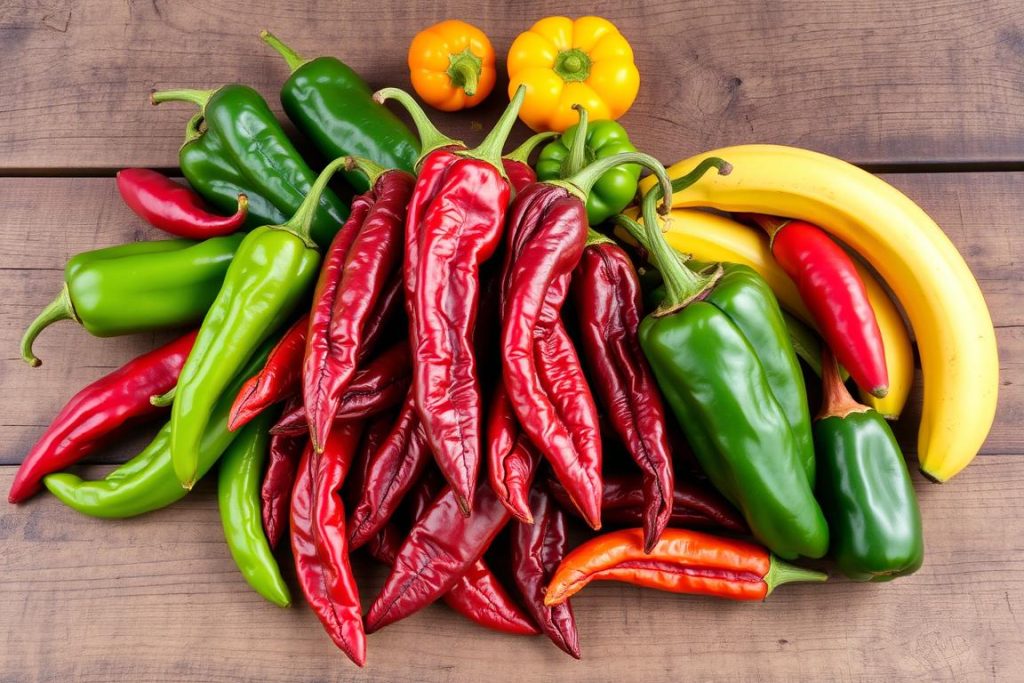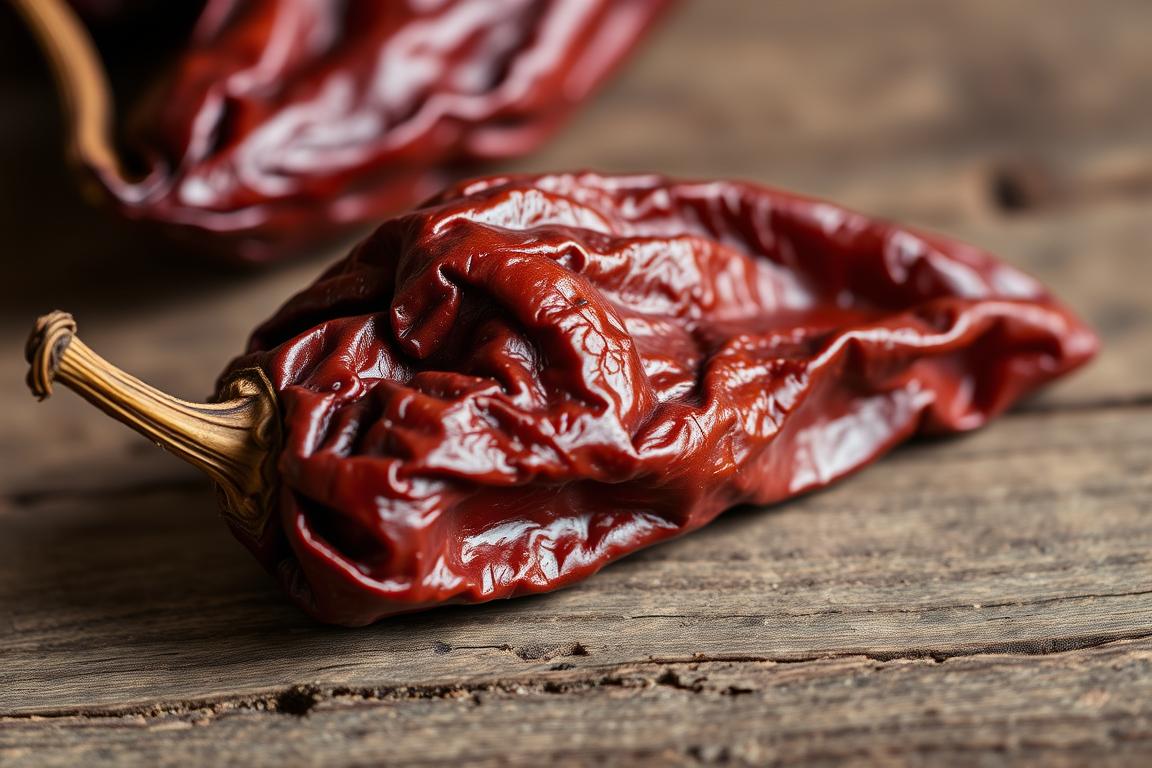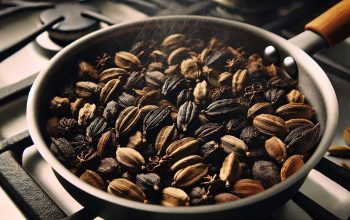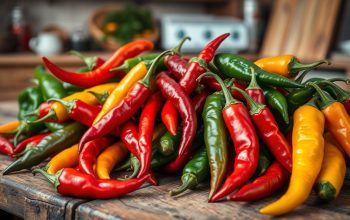The ancho chili is a key player in Mexican cuisine. It’s a dried poblano pepper with a mild heat and a smoky-sweet taste. This makes it a favorite in many traditional dishes.
Coming from Mexico, the ancho chili shows the country’s rich food culture. It combines the warmth of Mexican culture with deep flavors.
The ancho chili has a rich history in Mexico. It started as a simple poblano pepper but became a dried form with a unique flavor. Today, it’s a big part of Mexican food.
We’ll explore the ancho chili’s flavor, its traditional uses, and its role in modern Mexican cooking. It’s a fascinating journey into the heart of Mexican cuisine.
Introduction to Ancho Chili: The Dried Poblano Pepper
The ancho chili is a key ingredient in Mexican cuisine. It comes from the dried poblano pepper. This chili is very important in Mexico’s food history. Its taste and uses are key in many famous Mexican dishes.
Origin and History in Mexican Culture
The ancho chili comes from Puebla, Mexico. The poblano pepper is grown there a lot. For centuries, drying the poblano into an ancho chili has been a tradition passed down by Mexican cooks.
Traditional Uses and Significance
- The ancho chili is a must in mole sauces. It adds a mild, sweet taste to these complex dishes.
- It’s also used in braised meats, stews, and rubs for grilled meats. It makes the dishes richer and more flavorful.
- The ancho chili is also important in Mexican culture. It’s used in traditional ceremonies and rituals.
The ancho chili is a beloved ingredient in Mexican cuisine. Its history, versatility, and unique taste make it essential.
Understanding the Flavor Profile of Ancho Chilies
Ancho chilies are the dried version of the mild poblano pepper. They are known for their smoky flavor and moderate heat level. This makes them a great choice in Mexican cooking.
Compared to other chilies, ancho chilies have a unique taste. They are slightly sweet and earthy. Unlike hot habaneros or jalapeños, ancho chilies add a balanced flavor to dishes.
The drying process changes the fresh poblano into an ancho chili. This process caramelizes the natural sugars. It creates a rich, smoky aroma and a subtle sweetness that balances the spiciness.
| Chili Pepper | Scoville Heat Units (SHU) | Flavor Profile |
|---|---|---|
| Ancho Chili | 1,000 – 2,000 SHU | Smoky, slightly sweet, moderate heat |
| Jalapeño | 2,500 – 8,000 SHU | Earthy, slightly spicy, fresh |
| Habanero | 100,000 – 350,000 SHU | Intense heat, fruity, floral |
Ancho chilies are versatile and can improve many dishes. They are great in traditional Mexican moles and modern Southwestern meals. Their smoky flavor and moderate heat are key in many regional dishes.
“Ancho chilies are the heart and soul of many classic Mexican dishes, adding depth and complexity to sauces, stews, and rubs.”
Whether used whole, dried, or ground into chili powder, ancho chilies add a special touch to any dish. They are a must-have in every kitchen.
From Poblano to Ancho: The Drying Process
The change from fresh poblano peppers to dried ancho chilies is amazing. It brings out deep, complex flavors. The drying method is key, keeping the poblano’s unique taste while enhancing it.
Optimal Drying Conditions
Drying poblano peppers into ancho chilies needs careful control. A warm, dry place with good air flow is best. Watching the temperature and humidity helps the peppers dry evenly, keeping their oils and colors bright.
Color and Texture Changes
The peppers change a lot as they dry. Their green skin turns to a deep, mahogany color. The flesh gets leathery and wrinkled, showing the ancho chili’s unique texture.
Storage Requirements
- After drying, storing the dried poblano peppers as ancho chilies is key to keeping their quality and taste.
- Keep ancho chilies in sealed containers, away from light and heat. This stops them from drying out or losing their oils.
- Storing them in a cool, dark place helps them keep their sweet flavor and depth.
Turning fresh poblano into ancho chili is a careful process. Knowing the right drying and storage steps ensures your ancho chilies stay top-notch in taste and quality.
Culinary Applications in Mexican Cuisine
Ancho chilies, the dried version of the poblano pepper, are key in Mexican cooking. They add a mild, sweet flavor to many dishes. This includes the complex mole sauce and the tangy enchilada sauce.
Ancho chilies are also used in marinades, rubs, and seasonings. For example, they’re in adobo seasoning. This mix includes garlic, oregano, and other spices.
| Culinary Application | Flavor Profile | Typical Dishes |
|---|---|---|
| Mole Sauce | Rich, complex, and slightly sweet | Enchiladas, tacos, rice dishes |
| Enchilada Sauce | Tangy, smoky, and moderately spicy | Enchiladas, tamales, burritos |
| Adobo Seasoning | Savory, earthy, and slightly sweet | Roasted meats, grilled vegetables, marinades |
Ancho chilies are versatile in Mexican dishes, from old to new. They add depth and complexity to sauces, rubs, and seasonings. This makes them essential in Mexico’s rich culinary world.
Nutritional Benefits and Health Properties
Ancho chilies, the dried version of the popular Poblano pepper, offer more than just a delightful flavor profile. These versatile peppers are packed with a wealth of nutritional benefits and health-promoting properties. They make a valuable addition to any diet.
Vitamin and Mineral Content
Ancho chilies are a rich source of essential vitamins and minerals. They contain high levels of vitamins A and C. These vitamins are powerful antioxidants that support immune function and skin health.
Additionally, these chilies are a good source of B vitamins, iron, and potassium. All of these contribute to overall well-being.
Antioxidant Properties
One of the most remarkable aspects of ancho chilies is their impressive antioxidant capacity. These peppers are abundant in carotenoids, such as lutein and zeaxanthin. These have been shown to offer protection against cellular damage and reduce the risk of various chronic diseases.
Furthermore, ancho chilies contain a unique compound called capsaicin. This compound not only provides their signature heat but also exhibits powerful anti-inflammatory and pain-relieving properties. This makes ancho chilies a potential ally in managing conditions like arthritis, migraines, and digestive issues.
Incorporating ancho chilies into your diet can be a simple and delicious way to boost your nutritional intake and support your overall health and well-being. From their impressive vitamin and mineral content to their potent antioxidant properties, these flavorful peppers offer a wide range of benefits. They make a valuable addition to any kitchen.
How to Select and Store Ancho Chilies
Choosing the right dried poblano peppers and storing them well is key. This guide will help you pick and store ancho chilies easily.
Choosing the Best Ancho Chilies
When picking dried poblano peppers, look for these qualities:
- Firmly wrinkled with a deep, reddish-brown color
- Free from blemishes, mold, or signs of damage
- Pliable but not too soft or brittle
- Have a distinct, earthy aroma with hints of raisin or chocolate
Stay away from ancho chilies that look faded, dry, or crumbly. These may have lost their flavor and aroma.
Proper Storage for Maximum Freshness
To keep your dried poblano peppers fresh, follow these tips:
- Store the ancho chilies in an airtight container, such as a resealable bag or glass jar.
- Keep them in a cool, dark place, away from direct sunlight and heat sources.
- Avoid storing the chilies in the refrigerator or freezer, as the moisture can cause them to become soggy.
- Check the chilies periodically for any signs of spoilage and discard any that appear discolored or have a musty smell.
By following these guidelines, you can enjoy the rich, smoky flavor of ancho chilies for up to a year or more.
“Ancho chilies add a unique depth of flavor to Mexican cuisine that cannot be replicated with other peppers. Selecting the right ones and storing them properly is key to unlocking their full potential.”
Making Authentic Ancho Chili Powder
Starting with the right ingredients is key to enhancing Mexican dishes. Ancho chili powder, made from dried poblano peppers, adds a mild, sweet flavor. Making it at home lets you control the quality and adjust the taste.
Grinding Techniques
The right grind is crucial for ancho chili powder. Use a spice grinder or coffee mill to finely grind the chilies. For a coarser texture, try a mortar and pestle. But be careful not to overgrind, as it can make the flavor bitter.
Seasoning Blends
Ancho chili powder is even better with other spices. Mix it with cumin, garlic powder, oregano, and a bit of cayenne pepper. For a richer taste, add cinnamon or cloves. Experiment with different mixes to find your favorite.
| Ingredient | Quantity |
|---|---|
| Ancho chili powder | 2 tablespoons |
| Cumin | 1 teaspoon |
| Garlic powder | 1 teaspoon |
| Oregano | 1/2 teaspoon |
| Cayenne pepper | 1/4 teaspoon |
Mastering the grind and blend of ancho chili powder can transform your cooking. It brings the rich, smoky-sweet flavors of authentic Mexican cuisine to your dishes.
Essential Ingredient in Mole Sauce
Ancho chilies are key in making authentic Mexican mole sauce. This sauce is a mix of chili peppers, spices, nuts, and more. It’s a big part of Mexican cooking.
The ancho chili, a dried poblano pepper, is vital in many mole recipes. It adds a mild, sweet, and smoky taste. This makes the sauce rich and balanced.
| Mole Variety | Key Ancho Chili Contribution |
|---|---|
| Mole Poblano | Provides the base flavor and signature color |
| Mole Negro | Adds richness and complexity to the dark, earthy sauce |
| Mole Oaxaqueño | Lends a subtle sweetness and depth to the robust sauce |
The ancho chili is crucial for the taste and texture of mole sauces. It blends well with other flavors in Mexican food. This makes it a key part of the region’s cooking heritage.
“The ancho chili is the heart and soul of traditional Mexican mole sauces, infusing them with a perfect balance of mild heat, sweetness, and complexity.”
Ancho Chili in Modern Southwestern Dishes
The ancho chili has become a key part of modern Southwestern cuisine. It’s not just a traditional Mexican pepper anymore. Now, it’s loved by chefs and home cooks for its unique flavor in fusion recipes and modern cuisine.
Fusion Recipes
Innovative chefs are mixing the Southwest’s bold flavors with global tastes. They use ancho chilies in everything from spicy barbecue sauces to ancho-crusted pork tenderloin with tropical fruit salsa. This creates a mix of flavors that excites the taste buds.
Contemporary Applications
- Ancho chili-rubbed grilled salmon with a cilantro-lime aioli
- Roasted vegetable medley with an ancho-cumin vinaigrette
- Ancho chili-spiked chocolate truffles for a decadent dessert
Chefs are also using ancho chilies in modern Southwestern dishes. They’re making new versions of chicken mole and ancho-infused cornbread. These dishes show how versatile the ancho chili is, adding depth and complexity to meals.

The ancho chili is a symbol of the Southwest’s rich food culture. Its ability to fit into both old and new recipes makes it a favorite among food lovers. It’s sure to keep impressing people with its unique taste for many years.
Rehydrating Techniques for Optimal Flavor
Working with dried ancho chilies requires the right rehydration method to bring out their rich flavor. These dried poblano peppers need a bit of extra care. But, the effort is worth it for the amazing taste they add to Mexican dishes.
Soak and Simmer
The soak and simmer method is a common way to rehydrate ancho chilies. Start by putting the dried peppers in a bowl and covering them with hot water. Let them soak for 30 minutes to an hour until they’re soft and plump.
Next, move the soaked chilies to a saucepan. Cover them with fresh water and simmer for 15-20 minutes. This makes them fully rehydrated and tender.
Quick Microwave Method
If you’re short on time, the microwave is a quick fix. Put the dried ancho chilies in a microwave-safe bowl. Cover them with water and microwave on high for 2-3 minutes. Watch closely to avoid boiling water.
Once they’re soft, let them sit in the hot water for 5-10 minutes before using.
Optimal Rehydration Techniques
- Use hot water to speed up the rehydration process.
- Soak the chilies for at least 30 minutes, or until they’ve softened and plumped up.
- For best flavor, simmer the rehydrated chilies in fresh water for 15-20 minutes.
- Chop or blend the rehydrated chilies into your desired texture for the recipe.
Learning these simple rehydration techniques lets you unlock the full flavor of dried ancho chilies. You’ll make authentic, flavorful Mexican dishes with ease.
Remember, rehydrated ancho chilies add a wonderful depth of flavor to your dishes. They’re a key ingredient in Mexican cooking.
Popular Dishes Featuring Ancho Chilies
Ancho chilies are the dried form of the poblano pepper. They are key in many classic Mexican dishes. These mild, sweet peppers add a unique flavor to a variety of recipes.
The famous chili rellenos dish uses ancho chilies. It’s made by stuffing roasted ancho peppers with cheese or meat, then battering and frying them. This creates a mix of textures and tastes.
Enchilada sauce is another dish that highlights ancho chilies. The sauce is made by blending rehydrated ancho chilies. It’s rich and flavorful, perfect for enchiladas and other Mexican recipes.
“Ancho chilies are the backbone of many traditional Mexican sauces and stews, lending their unique flavor that is both mildly sweet and slightly earthy.”
Ancho chilies are also used in modern Mexican recipes. They add depth and complexity to fusion dishes and new takes on old favorites. Whether in chili rellenos or enchilada sauce, ancho chilies are crucial in Mexican cuisine.
| Dish | Description | Role of Ancho Chilies |
|---|---|---|
| Chili Rellenos | Roasted, stuffed ancho peppers that are battered and fried | Provide mild heat and earthy sweetness to complement the savory fillings |
| Enchilada Sauce | Rich, complex sauce made by rehydrating and blending ancho chilies | Create a balanced, flavorful base for enchiladas and other Mexican dishes |
Ancho Chili vs Other Mexican Peppers
Ancho chili is special in the world of Mexican peppers. It has a unique flavor and a certain heat level. It’s not the spiciest, but its taste is distinct from others.
Heat Scale Comparison
Ancho chili has a Scoville heat rating of 1,000 to 3,000 SHU. This makes it mild to medium hot. It’s perfect for those who like a little spice. Jalapeños and habaneros are hotter, with ratings of 2,500 to 8,000 SHU and 100,000 to 350,000 SHU, respectively.
Flavor Distinctions
- Ancho chili has a deep, earthy, and sweet flavor. It’s great in mole sauces and traditional Mexican dishes.
- Jalapeños have a bright, grassy taste with a bit of heat. They’re used to add a kick to Mexican food.
- Habaneros are very hot and have a fruity, floral aroma. They’re different from the milder ancho chili.
Ancho chili’s unique flavor and heat make it important in Mexican cooking. It lets chefs and home cooks explore its versatility in dishes.

“Ancho chili is the heart and soul of many traditional Mexican dishes, adding depth and complexity to the flavors.”
Growing and Harvesting Poblanos for Ancho Production
To make great ancho chilies, you need to grow perfect poblano peppers. These peppers love warm weather and need careful care. Knowing how to grow and harvest them will help you get a lot of ancho chilies.
Ideal Growing Conditions for Poblano Peppers
- Well-drained, nutrient-rich soil with a pH between 6.0 and 7.0
- Full sun exposure, requiring at least 6 hours of direct sunlight per day
- Warm temperatures, with daytime highs between 70°F and 85°F
- Consistent soil moisture, keeping the soil evenly moist but not waterlogged
Harvesting Poblano Peppers for Ancho Production
To get the best ancho chilies, harvest the poblano peppers at the right time. Poblano peppers should be harvested when they are dark green, firm, and have reached their full size. This usually happens 60-90 days after you plant the seedlings.
“Timing the harvest is crucial for the best ancho chili flavor and texture. Picking the peppers too early can result in a less developed flavor, while waiting too long can lead to a loss of sweetness and an increase in bitterness.”
After picking, the poblano peppers are dried. They can be dried in the sun or with a dehydrator. This drying makes the flavors richer and gives the peppers their unique ancho chili taste.
By following these tips for growing and harvesting poblano peppers, you can have plenty of high-quality ancho chilies. This is great for cooking and making delicious dishes.
Commercial Production and Global Trade
Ancho chilies, the dried form of the popular Poblano pepper, play a big role in the global spice trade. Mexico, where they originated, leads in chili production and Mexican exports of this valuable ingredient.
In central and southern Mexico, most ancho chili farms are found. These areas have the perfect climate and soil for growing these chilies. The global trade of ancho chilies is growing, showing their increasing popularity worldwide.
| Top Ancho Chili Producing Regions in Mexico | Annual Production (in metric tons) |
|---|---|
| Puebla | 15,000 |
| Oaxaca | 12,500 |
| Guanajuato | 10,000 |
| Hidalgo | 8,000 |
As demand for ancho chilies grows, Mexico remains the main supplier. It accounts for over 90% of the world’s chili production and Mexican exports. This makes Mexico the top source of high-quality ancho chilies.
“Mexico’s ancho chilies are celebrated for their rich, complex flavors and consistent quality, making them an indispensable component in cuisines around the world.”
The success of ancho chilies shows the hard work and skill of Mexican farmers and producers. They have perfected growing and processing these chilies over many years. As more people discover the unique taste of this Mexican pepper, the commercial production and global trade of ancho chilies will likely grow even more.
Conclusion
Ancho chilies are the dried form of the Poblano pepper, a key part of Mexican cuisine. They offer a rich, smoky-sweet taste and are very versatile. These chilies have become essential in both traditional and modern Southwestern cooking.
We’ve looked into the details of ancho chilies, from their origins to their use in dishes like mole sauce. This journey highlights their cultural importance and versatility. They are a must-have for anyone wanting to add depth to their Mexican-inspired dishes.
As you explore new recipes, don’t forget about ancho chilies. They can add amazing flavors to your dishes. Whether you’re making traditional Mexican food or something with a Southwestern twist, these peppers will impress your taste buds and inspire your cooking.



